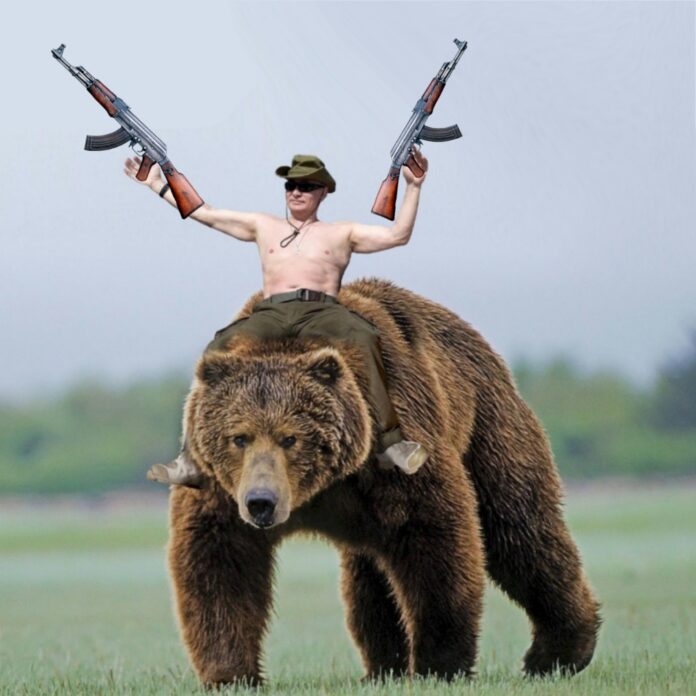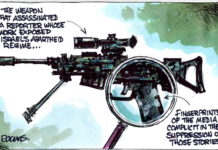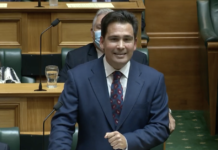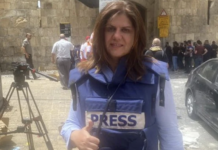Last week was very tense and the war escalated. The week included a range of planned and (probably) un-planned rhetoric and escalation making the situation more dangerous. Early in the week, amid commitments to increase arms supplies from NATO and its allies to Ukraine, the United States Defence Secretary Lloyd Austin remarked that a United States objective of supporting Ukraine would be a ‘weakened Russia’, after his meeting with President Zelensky.
Then the next day the United Kingdom’s Parliamentary Under-Secretary of State for the Armed Forces, James Heappey made a remark about attacking Russia, being a ‘legitimate’ use for weapons supplied by the United Kingdom. Both remarks were quickly clarified or ‘walked back by officials’ but demonstrate the need for politicians on both sides to be very careful about their speech.
In Russia, the comments hit home as Putin wound the Russian people up, using these statements as evidence to inflame Russians and demonstrate that he was correct, that the war in Ukraine is a war against NATO and the United States. A war for survival. Later, in the week we had nuclear rhetoric and threats from both Putin and his foreign Minister Sergei Lavarov. The Pentagon also reported that the Russians are secretly preparing for a full mobilisation of their military, a significant step essentially moving the war from a military expedition to total war.
This week, Putin also attempted to blackmail NATO by cutting of natural gas supplies to Poland and Bulgaria and escalated his rhetoric including talking about expanding the war into other countries. Combined with attacks on fuel infra-structure in Transitria and Russia the week was full of tension.
NATO is walking a fine diplomatic line, it must oppose Putin’s aggression, whatever the potential consequences. The simple fact is that the history has shown, again and again that autocrats and tyrants must be met with force; and if not, they only escalate their demands. In the 18th and 19th centuries Europe combined to oppose Napoleon, in the 20th Hitler. Putin is the next in a rogue’s gallery of tyrants that believe ‘might is right’. History shows that the only way to oppose these people is collective security, or for the nations that do value human rights, national sovereignty and the ‘rule of international law’ to work together using their collective strength to oppose them. That is why alliances like NATO exist.
The difference today is that Putin has a large nuclear arsenal. Opposing Putin, requires accepting that threat of global nuclear war. Strategically, the mitigation for this threat is making sure that NATO’s dialogue is unemotional, that it is tied to principles of international law. This means that discussion focusses on Putin’s actions, rather than conflating his actions with Russians generally. It is an important distinction because it provides opportunity for any opposition within Putin’s military or political circle to reasonably argue against nuclear escalation on the grounds on an existential threat to Russia. People may be able to sacrifice themselves, their children and their children’s children for their country, however are less likely to make that sacrifice for one person. So, it is important that NATO leaders choose their words carefully to ensure; that if they choose too, Russians can distance themselves from Putin.
At the moment the war is at critical phase. Tactically, the Russians are struggling to win ground. In the east they are making some very limited progress. However, bad weather, heavy losses and poor morale mean that Russia’s probing attacks are not making significant progress. It is likely that there is a ‘second echelon’ preparing to be committed either south from Izyum to take Kramatorsk and Sloviansk or west from Luhansk through the towns of Rubizhne, Kreminna and Popasna to attack Severodonetsk. However, at this stage where this attack will fall is uncertain and last week’s Russian activity has failed to find a Ukrainian weakness. Likewise, in the south the Russians are still unable to advance further than Kherson.
Ukraine on the other hand is receiving huge amounts of military equipment and supplies from a world-wide coalition. The NATO reports indicate that the Russia is struggling to maintain air-superiority over even eastern Ukraine. NATO flooding Ukraine with anti-aircraft missiles has driven Russian planes from most of Ukraine’s airspace. Everyday Ukraine gets stronger.
The war is in the balance tactically, Russia either needs to win quickly, escalate or negotiate. The chances of Russia winning with its current forces are minimal. The Russian’s simply do not have the numbers that they require. All the artillery in the world cannot seize and hold ground, his requires infantry and Russia is running out of infantry.
This means that Russia is now faced with a number options;
- Nuclear escalation.
- Mobilise and escalate conventional operations.
- Negotiate.
The first option, nuclear escalation while ‘on the table’ is unlikely. Using tactical nuclear weapons would turn more nations against Russia and based on NATO’s current resolve could see a significant NATO escalation. Using tactical nuclear weapons may convince NATO to impose a ‘no-fly’ zone or even to escalate further and attack Russia’s tactical nuclear weapons supporting infra-structure (i.e. their bases, maintenance and supply areas) to prevent further use in the conflict. Use of strategic nuclear weapons is unlikely because their use creates a no-win outcome.
The second option, conventional escalation is highly likely. To date, Pentagon intelligence has been very accurate and if it reports that Russia is preparing for general mobilisation it is likely to be in progress. A declaration of war against Ukraine and mass mobilisation would allow the full military power of Russia to be deployed against Ukraine. This could provide the resources to win quickly in the east and then negotiate. The risks for Russia are that the Ukrainians may still beat them and further diminish Russia’s prestige and military resources. Further, if the Ukrainians can hold on for a long-time, they may even force the Russian economy to collapse.
Another question is whether Russia would risk conventional escalation beyond the borders of Ukraine, into a NATO state. Would Russia follow through on its threats to Britain or Poland? This option is highly unlikely because NATO is holding its resolve, rather than backing away from Russian threats the alliance is escalating and demonstrating that it is willing to fight. NATO and its allies vastly outnumber and overpower Russia. Escalating into a war with NATO would destroy Putin so is unlikely.
The final option is negotiation. I noted with interest that this morning Sergei Lavrov was ‘walking back’ his recent nuclear rhetoric and also that evacuations of civilians from Mariupol are being discussed. Perhaps, NATO’s resolve is bearing fruit and we are approaching a realisation in the Kremlin that negotiation could be a better option than continuing the war? The evidence for this is not good, it seems more likely based on recent history that Putin is stalling while he prepares his next move.
Last week it was reported that Russia Chief of General Staff General Valery Gerasimov, is in Ukraine assessing the situation this visit will likely set policy for the next phase of the war. This trusted general will be finding out what is happening on the ground and reporting back to Putin and there are likely to be some rapid changes in the next week, before Victory Day on 9th May. Most likely, based on Russian behaviour to date a commitment of remaining forces to one axis of advance either in the north-east or in the south towards Odessa followed by general mobilisation to replace the loses and continue the war.
Ben Morgan is a tired Gen X interested in international politics. He is TDB’s Military analyst.






What is happening in real time is the destruction of Ukrainian lifes. Read this harrowing account from a French lady frontline reporter. https://www.moonofalabama.org/
Esculation from leaders l like Boris Johsnstone, Biden and their respective equally idiotic Govternments is Bad …
A winner means a loser ,,,, a loser means tactical Nukes ,,, I’d give it between 10 minutes to 3 hours before the big Ballistics and a whole lot more were following the tactical ones.
The NATO Proxey war shows what amounts of money governments can throw at problems people are facing ,,, Jacinda changing her name to Ardernsky could cut our growing NATOstan partnership bill,,, which is due again.
https://www.youtube.com/watch?v=N3pnFR7DeZA&t=3s
Nuland and Blinkin think Putin is bluffing ,,, its a grim bet they going big on for us ,,, – Ukraine and the Doomsday Machine – https://youtu.be/YTXoYTt80T8?t=1789
*********************************************
Today is the anniversary of the Odessa massacre against Russian Ukrainians ,,, which took place in 2014 ,,,, spurred the rejection of the Kiev coup by the ethnically russian Ukrainians in Donbass and Luhansk…
And Lead to NO or ZERO prosecutions since ,,, Because the Coup Govt were racist against russian Ukrainians .
Zdelinsky has declared a winning Ukraine will rule like Right wing Israel ,,, he told Israels Parliament that Russians were Ukrainians Palastinians ,,, but were also doing a Holocaust on.
Anyway not caring about no convictions against these Russian victims ,,, shows the sort of democracy we support ,,,, ones with NATOstan hatred of Russians.
Parts of Their media were cheering this on back then,,,, I was getting The Standard ‘ neocon’ treatment back then ,,,, I remember Wayne Mapp saying there was not much the west could do to settle these violent lands/people.,,,, so NATO trained and adopted the violent ones.
AZOV was at this Odessa mass murder before they became AZOV ,,, Dynamo Kiev and other violent soccor thugs ,,,
Lots of shouts of Slava Ukraini when murder fever on Russians gets going… in this R18 very violent but very informative doco ‘ Burnt Alive in Odessa’ https://www.youtube.com/watch?v=wu2tXG2Yo-g
A brief non violent video describing the anniversary and events around the crime and time … https://youtu.be/wQ4A6NVHruw?t=421
Very informative as this shortly preceded the civil war and 8 years of NATO training of civilian attacking anti-russians that our Brenton Tarrent ANZOV bro admires.
Currently most of the Russian troops are contracted conscripts from the poorer areas of Russia. Great cannon fodder as it does not effect the young people in the urban centres such as St Petersberg or Moscow.
If Putin moves to general mobilisation the protected young in those middle class urban centres may not like being called up. OK for country bumkins with no other income but to join the army on two year contracts, but getting urban middle class youth to serve might be difficult. Have a look at the You Tube channel 1420. The war has not hit home in the urban centres or their populace.
Putin also faces another middle class problem. The value of the Russian passport to enable travel. It is eroded and the middle class youth, used to being able to freely travel, will not like being only able to visit China, Syria or North Korea. Never mind being forced into carrying arms to fight.
https://www.nzherald.co.nz/travel/russian-passport-stagnates-in-power-index-as-new-cold-war-affects-mobility-levels/Z2EGR2CGGYKZG77OAKOCV5J66Y/
and
https://ftnnews.com/tours/43728-russia-s-passport-downgraded-to-junk-status
THE VERY ISSUE THAT FORCED AMERICA OUT OF VIETNAM….if ‘dumb rednecks’ hispanics and urban blacks die who cares….but a whiff of gunsmoke anywhere near conscripted middle class students —-whooooah guys give peace a chance
Yes and the same will apply for Ukrainians
Good analysis, thanks.
The longer this goes on, the more Russia loses: Loses in so many ways.
which is the yanks plan…’we will fight to the very last ukrainian to wear russia down’
I am curious as to Ben’s approach to Poland and Bulgaria refusing to pay for their gas in rubles., and then whinging that they’re being blackmailed Isn’t the refusa itself an attempt at blackmail?
Hypocritically they still plan to buy Russian gas , backloaded from Germany, with a little dollop of profit on the German’s side no doubt.But Russia says if it sees this happening, it will not increase the volume.Their sales of oil to China has increased by 67% compared to the same time last year.Even with a discount to a “friendly”, the spike in price , along with increased sales to India, more than compensates for the loss of sales to Poland and Bulgaria
Great that the UN and the Red Cross , along with Russia , or rather the DPR (check out the white armbands in the videos ), have finally managed to shame the Azov boys into letting some civilians escape from Azovstal
By the way, the appearance of the civilians is not quite as dire as we were led to believe.Some plush looking suitcases, clean clothes and rather well fed dachsunds were to be seen heading for the buses.
Some of the interviews of the civilians we saw in the western outlets, are abbreviated to convey an ambiguous story.You can find the longer videos , which allude to Azov “aggression ” towards some of the civilians on Youtube
I’m wondering if this war is the most propagandised ever.Certainly in my close to 70 years,I’ve never come across so many outright lies, where the assertions of one party,Zelensky for eg , are taken holus bolus as the truth
Unbiased commentary from https://southfront.org/hard-lessons-and-new-developments/
It indicates that for the average Ukrainian soldier they are getting thrashed. Z needs to stop now before he kills off huge numbers of Ukrainian men losing his whole country.
The tactics of the Russian Army and of the AFU have changed. The key difference between the last five weeks of the Russian military operation is the dramatically reduced losses of the Russian army, both in killed or injured and in prisoners of war. The reason is that the initial tactic of primarily rapid advance has been abandoned and replaced by a war of attrition and material which employs slower advances preceded by heavy artillery preparation and airstrikes. Before the assaults on each subsequent Ukrainian defensive line, the ground advance stops, and artillery and aviation take over the leading role. After the defending Ukrainian forces either retreat or surrender, the advance resumes. One should not expect quick spectacular breakthroughs, but a positive final result is more reliably achieved. The goal is on grinding down the AFU’s manpower.
The AFU, on the other hand, uses slightly different tactics. Large groups of less trained fighters are used as a cannon fodder. First, they are sent to the front line to provoke Russian fire and detect Russian positions. Then Ukrainian fighters open return fire.
This is precisely why NATO is supplying Ukraine with 155 mm artillery. These guns have a longer range than standard Russian artillery and also have smart targetable munitions. The intent is to give the Ukrainian Army effective counter battery fire. Take out the Russian artillery and neutralise their advantage.
Artillery has long been a dominant part of Soviet war fighting doctrine, and the Russian Army is pretty much using Soviet era military doctrine. In fact, as far as I can see a large percentage of their weapons date from the 1970’s and 1980’s. Many, many years ago I was an Intelligence Officer in the NZ Army, and Soviet tactics and weapons were a major part of my study. From what I have seen over the last two months the Russian Army still operates pretty much in the way that the Soviet Army did.
This is why the Ukrainians have put so much emphasis on getting heavy weapons. Eastern Ukraine is the steepe, open country much more suited to traditional mobile warfare than the area around Kyiv. Ambushes by hand held missiles are more difficult since there is not the same amount of cover. Long range weapons come into their own, mostly artillery, but also battlefield missiles (50 – 80 km range). That also means it is necessary to counter to such weapons, specifically counter battery fire, hence the 155 mm guns with artillery spotting radar. This radar locks on to the incoming shells, calculates their point of origin and enables a counter strike. Such artillery needs to be highly mobile. It seems the Ukrainians have already received hundreds of such weapons.
It won’t be long before Ukraines also gets close air support aircraft, initially Mig 29’s and Su25’s in a ground role. But I reckon Ukrainians pilots will soon be training on F 16’s and Apache helicopters. These are both superior to Russian aircraft since they have superior targeting and battlefield data systems. It is in these areas where Western systems are generally superior. I would also note that contemporary Western tanks, having been much more recently developed, would not be nearly as vulnerable as Soviet era T72’s and T80’s which were probably manufactured around 40 years ago.
All very well Wayne, but they have to get to the front, 500kms by rail, bridges and power knocked out, no air cover, no fuel. Then theres hauling sufficient quantities of ammunition. Not enough transport, no fuel. Logistics, logistics, logistics.
The most likely scenario is that heavy weapon supplies will be struck in western Ukraine by hypersonic missiles. They stand very limited chance of getting to the front. Too little, too late.
It is harder to target the convoys than you think. Russia would need air supremacy, which they don’t remotely have. The Ukraine road and rail networks are mostly still operable.
Yes, Russia may destroy 5 to 10% of the heavy weapons before they can be deployed, but I think they will do well to even achieve that.
I understand a fair amount of the artillery is already in theatre. The US will have used its stocks of 155 mm guns already in Europe for the first supplies. It would only take a week or so to get them from Germany to the front, with the Ukrainians picking them up in the consolidation points in Eastern Poland, where there will have been a couple of days of familiarisation training of Ukrainian artillery specialists. The announcements of the intention to supply the 155 m guns was more than two weeks ago.
In which case you are out of date. Ukraine has acknowleged that the Russians have cut the rail bridges to the east with rocket attacks plus taken out the main electric substations to the west in effect crippling the rail network. They have used rocketry to destroy fuel distribution. On top of that in the east Ukrainian troops acknowledge there is no air cover.
Check on Southfront and others, Ukraines supply lines are broken. No food, no ammo, no fuel.
Ben, pull you up on the comment about blackmail by cutting gas supplies.
First Russias overseas cash and gold were confiscated, then Russia was sanctioned so that they couldnt spend dollars or euros. So they said pay us in gold or rubles. Poland refused, Russia said we are not a charity.
Who blackmailed who? If your company sold mine services, and I refused to pay the bill, and demanded further delivery what would you do?
the thing is unintended consequences if the world gets used to paying in roubles or yuan where does that leave the petrodollar….?
goodnight america.
plus and I’m not being glib here I’ve tried to rack my brains..but can anyone think of any sanctions that ever achived anything? serious question…societies adapt…Iran is still with us, as is cuba.
Yup common trope amongst the western elite . I assume Ursula von der Leyen knows she’s spouting shit
but I wonder what your average European thinks . The cause and effect is obvious but some are too dim to figure it out .
Unbiased commentary from https://southfront.org/hard-lessons-and-new-developments/
It indicates that for the average Ukrainian soldier they are getting thrashed. Z needs to stop now before he kills off huge numbers of Ukrainian men losing his whole country.
The tactics of the Russian Army and of the AFU have changed. The key difference between the last five weeks of the Russian military operation is the dramatically reduced losses of the Russian army, both in killed or injured and in prisoners of war. The reason is that the initial tactic of primarily rapid advance has been abandoned and replaced by a war of attrition and material which employs slower advances preceded by heavy artillery preparation and airstrikes. Before the assaults on each subsequent Ukrainian defensive line, the ground advance stops, and artillery and aviation take over the leading role. After the defending Ukrainian forces either retreat or surrender, the advance resumes. One should not expect quick spectacular breakthroughs, but a positive final result is more reliably achieved. The goal is on grinding down the AFU’s manpower.
The AFU, on the other hand, uses slightly different tactics. Large groups of less trained fighters are used as a cannon fodder. First, they are sent to the front line to provoke Russian fire and detect Russian positions. Then Ukrainian fighters open return fire.
Another excellent piece from NATO insider Jacques Baud at
https://www.thepostil.com/our-interview-with-jacques-baud/
” A declaration of war against Ukraine and mass mobilisation would allow the full military power of Russia to be deployed against Ukraine. This could provide the resources to win quickly in the east and then negotiate. The risks for Russia are that the Ukrainians may still beat them and further diminish Russia’s prestige and military resources. ”
Really ??